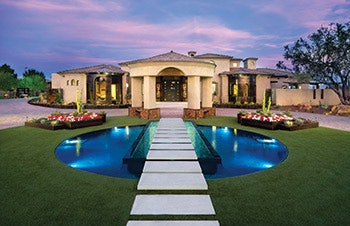
In the June edition of AQUA Architecture you’ll find a profile of a truly extraordinary project, “Rustic Contemporary” by Rick Chafey and Brett Blauvelt.
Like many profiles of great work, the discussion covers an extremely high-end project for a wealthy, and in this case, famous client and his young family. What is highly unusual is that Rick and Brett’s firm, Red Rock Contractors and Red Rock Pool and Spa, not only built the pool and exterior elements — they also built the home. As you’ll see, the project is a truly shining achievement in design integration and features a spectrum of appealing elements.
I bring this up because from time to time, some people question the value of covering such high-flown work. The reservation is simply that very few people in the industry ever have an opportunity to work for clients with almost unlimited budgets, and certainly even fewer will design and build the home along with the exteriors.
It’s a reasonable critique because it’s true that projects of this scope are rare. So why cover them when so few of you will have the opportunity to work on such a large-scale project? Do such projects garner exposure because they make for pretty pictures? Or is it simply a matter of sensationalism?
Fortunately, the answer is far more grounded: these so-called “high-end” projects are where some of the most creative ideas are germinated. It’s where the concept of “style” comes forward in the most dramatic ways. The goal in presenting this type of work is not to presume that everyone will find themselves with such projects, but instead to inspire creativity across the economic strata.
Whether it’s realized or not, most if not all aquatic installations have some form of style; thus understanding the design principles that define style is relevant to everyone in the industry. Consider that pools almost always represent a significant investment on the part of the homeowner. It’s reasonable to assume that even relatively modest installations should convey a sense of place, of setting and of stylistic direction.
Often those considerations are relatively simple: working with a given style might mean understanding the color palette in play, or the reasoning behind going with a geometric shape, or conversely a vessel with multiple radii. If you’re working in the vinyl liner market, style might boil down to choosing a pattern with a quatrefoil or fleur de lis to pick up forms present in the home or surrounding landscape. Or it might mean using a more organic pattern to harmonize with a garden setting.
To a large extent, understanding style boils down to vocabulary. It’s the shared language that enables the builder to relate the aesthetic choices and decisions to the homeowner. And later on, those style points very often become points of pride for the client.
It’s human nature: We are pre-wired to appreciate visual beauty. It’s why we like nice clothing, attractive cars and appealing furnishings in our homes. Certainly some people are more subject to visual aesthetics than others, but there’s no question that to some extent, visual appeal equals value in the minds of many.
That’s why I personally believe that if you look at a project like the one Rick and Brett cover in these pages and quickly dismiss it, with all due respect, I think you’re missing the point. Within the myriad of stylistic decisions encompassed in this amazing project resides a lexicon of stylistic details that can be appropriated to work on a far more modest scale.
And, frankly, when you look at highly creative work through that kind of open-minded lens, considering style becomes inspiring and even fun. Being stylish isn’t just for the rich and famous, it’s for everybody — no one is immune.
Comments or thoughts on this article? Please e-mail [email protected].












































